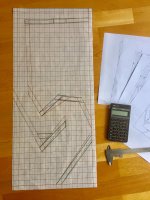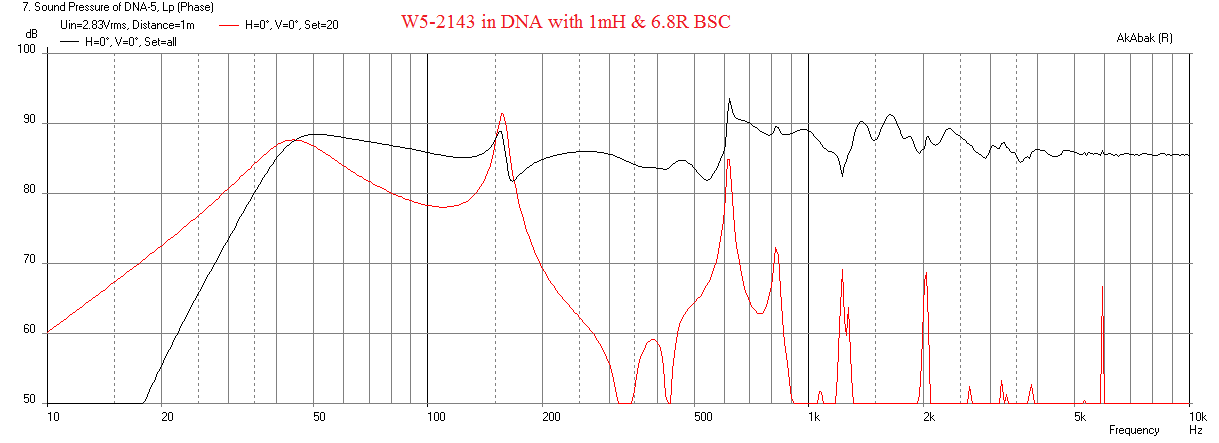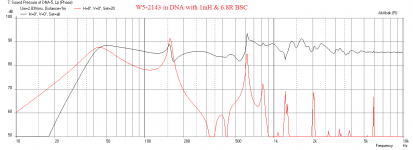FWIW, in their final home our prototype build was fitted with Alpair10P, which is (for now?) Steve's favorite for the design.
Now I'm quiet a fan of the driver, and the DNA was fun and all but 9.96 octaves and magically transforming the sensitivity / "efficiency" to 93/94 dB, is a bit of a stretch.
Now I'm quiet a fan of the driver, and the DNA was fun and all but 9.96 octaves and magically transforming the sensitivity / "efficiency" to 93/94 dB, is a bit of a stretch.
Last edited:
chrisb, I just went through your drawings. Fabulous! Thanks for sharing, it will make it so much easier for me to flesh this thing out. Swappable drivers would be nice but I don't know how to implement it in a way that would also pass the WAF? But it totally make sense from a "manly engineering" point of viewFor the time and effort that would be involved in the DNAs, I's suggest making with a removable panel for mounting different drivers.
I am pretty happy if I get 90 dB out of them and manage to get my subwoofers XO down to 50 Hz.FWIW, in their final home our prototype build was fitted with Alpair10P, which is (for now?) Steve's favorite for the design.
Now I'm quiet a fan of the driver, and the DNA was fun and all but 9.96 octaves and magically transforming the sensitivity / "efficiency" to 93/94 dB, is a bit of a stretch.
Re swappable drivers - the DNAs are not the first time I've done this. I fabricate the cabinets with a large rectangular opening on the front panel, fitted with threaded inserts in at least the corners, and a series of removable baffle plates cut for each driver model. Attach with machine screws and seal with self adhesive closed cell weatherstripping foam tape - if it was rocket science I'd not likely be able to implement or describe it.
The WAF test? - always a different story - good luck with that
The WAF test? - always a different story - good luck with that
Thank's again chrisb, your drawings made it super simple to transfer it onto pattern paper that I then laminated so that it will hold up in the shop. It is a surprisingly compact design. 
I ran into a couple of minor problems. I used your drawings witch seems to indicate 15.4 mm material thickness. I converted that to 16 mm and my first attempt was the orange lines. I then went over all measures again and made some correction due to my errors but also since two figures didn't add upp down in the fold. Corrections are the green lines. I then checked the horn profile and made one final alteration to make sure the horn expanded throughout the whole length and through the fold. The alteration is the blue lines.
I am looking forward to build this speaker as soon as I taken the time to clean up the shop...
I ran into a couple of minor problems. I used your drawings witch seems to indicate 15.4 mm material thickness. I converted that to 16 mm and my first attempt was the orange lines. I then went over all measures again and made some correction due to my errors but also since two figures didn't add upp down in the fold. Corrections are the green lines. I then checked the horn profile and made one final alteration to make sure the horn expanded throughout the whole length and through the fold. The alteration is the blue lines.
I am looking forward to build this speaker as soon as I taken the time to clean up the shop...
Attachments
FYI, the measures in my pdf did not match up with the drawings from chrisb in post #239. I went with the drawings from chrisb because they seemed more accurate.I am reviving this thread because I am about to build a pair of DNS and took some measures on top of the drawing from post #58. It's the one to use right? Dimensions seems about right and I will try to rescale it for 16 mm (no 1/2 inch sheets in Sweden). Attached is a pdf with my overlaid measures in cm. Ballpark figures I know but hopefully good enough to base my build upon...
I recall Bcmbob having some difficulty in getting the plans to close on itself. You may need to juggle a few dimensions towards the middle sections and mouth to fit. The critical dimensions are near the driver entrance, the chamber volume, and the home from driver to horn. Towards last half, a few mm bigger or smaller won't change things hardly at all. So feel free to jiggle the numbers a little to get it to all fit.
My attempt at reverse engineering the dinensions ended up like this (from post 1):
http://www.diyaudio.com/forums/atta...speaker-enclosures-decware-dna-dimensions.pdf
Nice calculator btw. HP 32S II is arguably the best RPN HP ever made from usability and speed standpoint. I still use mine.
My attempt at reverse engineering the dinensions ended up like this (from post 1):
http://www.diyaudio.com/forums/atta...speaker-enclosures-decware-dna-dimensions.pdf
Nice calculator btw. HP 32S II is arguably the best RPN HP ever made from usability and speed standpoint. I still use mine.
Last edited:
The first HP calculator I bought for College was a HP-15C and I have always loved that calculator. I kept it and the users manual in mint condition for many years until one day when I got home from work and it looked like someone had chewed on it! Bite marks around the display and even saliva under the glass. Turned out that my wife had given it to our baby daughter to keep her occupied while my wife was on the phone. She could not understand why I was upset and just told me to buy a new one. Pretty ignorant since only the HP-12C was available new at that time and what engineer with some self respect would carry a "financial calculator"?Nice calculator btw. HP 32S II is arguably the best RPN HP ever made from usability and speed standpoint. I still use mine.
Years later a new colleague had the HP-32S II on his desk. I asked him about it and he said he got is as a present from his previous employer. He had newer used it because he was not familiar with RPN. I offered to teach him but he offered me his calculator instead, for free. I am still grateful because it is a great calculator and it enables me to use RPN, to me the most efficient and natural way of doing math. I am still missing my old 15C but the 32S is a great substitute. If I only could come up with a way of getting hold of another colleagues HP-16C, the rare "programmers calculator"...
…RPN...
I had a number of HPs including an HP11 & 15. I probably still have one with dead batteries. The calculaters on my Macs emulate HPs (Pcalc). My favorite programming language was/is Forth which is RPN.
dave
I compared your drawing with the ones by chrisb again and there are quite big deviations, number wise. Yours are narrower at the beginning of the horn and wider at the end. But I have to commit to something so I am going with the drawings by chrisb. I will probably make one more alteration in the fold (based on what I see in your drawing xrk971) so I will end up somewhere in between. But this is a bit of a crapshoot anyway since I don't even got the correct drivers. I just hope the W5-2143 is close enough to make it worthwhile.My attempt at reverse engineering the dinensions ended up like this (from post 1):
http://www.diyaudio.com/forums/atta...speaker-enclosures-decware-dna-dimensions.pdf
Dave, have a look at ebay, they are still quite common but people collect and pay good money for them. So take care of them and don't leave batteries in the battery compartment if you don't use them. Leaking batteries are always a mess...I had a number of HPs including an HP11 & 15. I probably still have one with dead batteries.
Sanity check, drawings by chrisb got 25.4 mm (1 inch) at the beginning of the horn, xrk971 got 0.58 inch (14.732 mm) for the same measure. For the next measure (where the horn bends downward) chrisb got 31.7 mm (1.248 inch) where xrk971 got 0.88 inch (22.352 mm). This seems like a quite crucial run and therefor big deviations (some 30..40% off). So what do you all think? Go with the wider or the narrower horn figures? I wish I knew where chrisb got his figures from...
I think Chrisb said his drawings were made from official plans he got from Decware. Mine were extracted with dial calipers from a web render with perspective correction. So could be off, but they simulated well. Let me run sim of my narrow channel version on 2143. If it works then the narrow dimensions are good.
That could be one way to move forward, sim it with a wider vs. a narrower. I guess you could over do it just to get an idea of how it would react either way. I also thought chrisb went of the official drawings and that is why I try to stick to them. The initial values for the horn is awfully close to 1" and 1"1/4. A few values does not add upp if you go back and forth but it could be a simple error. I will apply some common sense and hope for the bestI think Chrisb said his drawings were made from official plans he got from Decware. Mine were extracted with dial calipers from a web render with perspective correction. So could be off, but they simulated well. Let me run sim of my narrow channel version on 2143. If it works then the narrow dimensions are good.
Thank's a lot xrk971! Looks much better than I expected. I am currently using my W5-2143 with a pair of sealed subwoofers and I have to cross them between 80-100 Hz. I would be super happy if I could get that down to 50 Hz or even do without the subs all together. I wish I could corner loaded them but I have to put them along a wall (with openings to adjacent rooms on each side). I wonder how close to the wall you can position the DNA? That's why I was playing with the idea of flipping them 90 degrees making them side vented. I guess the design allows you to put the driver on the wider side instead of the intended front baffle, right?Here is sim with W5-2143 into my model. Looks pretty good - will need a BSC of 1mH and 6.8ohms to give a balanced response though. otherwise treble too high relative to bass.
Ps. The sim, did you run it with "your narrower horn"?
- Home
- Loudspeakers
- Full Range
- Decware DNA Horn


